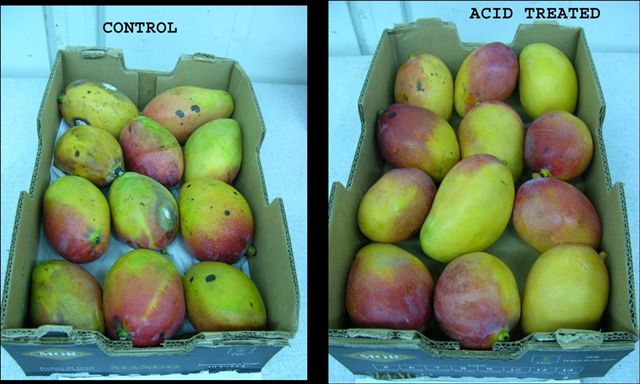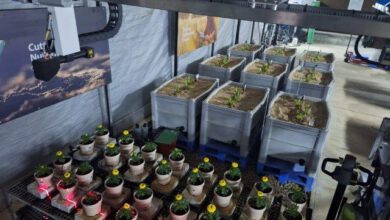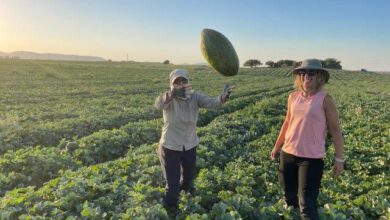New Ideas for Improved Fruit Quality and Human Health
Acid prochloraz treatments repesent a new approach to disease control and fruit-quality improvement
D. Prusky and I. Kobiler

acid prochloraz treatments offer a new approach to disease control and fruit-quality improvement while, at the same time, improve safety by reducing the concentration of prochloraz applied as a postharvest fungicide.
simple observations are the basis of key developments in science. observations of ph changes induced in the colonized tissue of decayed fruits by several postharvest pathogens revealed a significant shift in the host ph – a shift whose size and direction depended on the pathogen. the environmental ph in fruit tissue may change, either naturally during ripening or as induced by the pathogens, and studies revealed that the fruit environment was either alkalinized or acidified by secretion of ammonia or organic acid, respectively, during pathogen colonization. avocado and mango fruits colonized by colletotrichum showed increased ph in the decayed tissue by 2 ph units, whereas, in contrast, in apples and citrus fruits colonization by
.jpg)
penicillium sp. reduced the colonized tissue ph by up to 1 ph unit. from these intriguing and simple observations have sprung a series of basic developmental analyses and new technologies that are used worldwide to improve fruit quality and safety.
the factors that determine fruit and vegetable ph during fungal colonization are the same ones that determine the capability of the pathogen to successfully colonize, invade, and kill the targeted host, with the aid of secreted pathogenicity factors. since ph is a critical consideration in the fungal attack strategy, the pathogen cannot simply adapt to whatever ph characterizes its target fruit. therefore, fungi have developed environmental sensing mechanisms that enable them to modify the ambient conditions to best suit their offensive arsenal and, at the same time, to compromise the fruit defenses against postharvest pathogens. to survive under the varied ph conditions they have developed mechanisms to monitor the external ph, and they respond by regulating the entry and exit of appropriate ions such as ammonia and organic acids.
the ability of the postharvest pathogen to locally alter the ph has been described for colletotrichum spp., alternaria alternata, botrytis cinerea, penicillium expansum, p. digitatum, p. italicum, phomopsis mangiferae, and fusarium oxysporum. ambient alkalization in decayed fruits by c. gloeosporioides and a. alternata is achieved by active local secretion of ammonia, which increases its concentration up to 5 mm. other pathogenic fungi, such as p. expansum, p. digitatum, p. italicum, ph. mangifera, and b. cinerea acidify the fruit tissue during their attack by secretion of organic acids as gluconic and oxalic. this fine-tuning by the fungus is a prerequisite for enzyme induction needed for colonization and demonstrates the importance of the specific regulatory system during fungal colonization of stored fruits and vegetables.
the significant changes in environmental ph induced by the pathogens suggested the possible use of these findings to modulate fungal colonization and to control postharvest diseases. control of postharvest diseases of tropical and subtropical fruits and vegetables is vital for maintaining their quality and shelf life during long periods of storage, under conditions in which the postharvest use of fungicidal treatments is severely limited. postharvest diseases might be controlled by either pre- or postharvest treatment, or even by a combination of the two in cases of high incidence of disease. however, new, strict regulations regarding fungicide residues, and the reductions by local authorities of the legal acceptability limits of specific fungicides make the development of new postharvest decay-control treatments for fruits an important factor in improving their quality, and their safety for humans and the environment.
two aspects of ph regulation are important for the control of postharvest diseases, because the ph: (i) influences the initiation of pathogen colonization of host tissue, and (ii) affects the toxicity of the fungicides used to control these diseases. black spot, caused by a. alternata, is an economically important postharvest disease of mango and persimmon fruits worldwide, including the subtropical growing regions of israel. the primary mode of infection of mango fruits by a. alternata is by direct penetration through the lenticels during fruit growth, followed by quiescence until the fruit is harvested and ripens during long storage periods or shelf life. postharvest development of alternaria rot symptoms in mango fruits during storage is usually prevented by hot water brushing in combination with prochloraz at 225 µg ml-1 – treatment that leads to eradication of latent infections that were initiated in the orchard, and consequently prevents fungal colonization. the finding that a. alternata alkalinizes the host-environment ph stimulated examination of the possibility of modulating the environmental ph by acid treatments, as a means of reducing fungal colonization; and organic and inorganic acids are currently being used commercially in all mango packing houses in israel (fig. 1).
the second use of ph to improve fruit quality and food safety involves exploitation of the influence of ph on the activity of fungicides, as a mechanism for improving the solubility of fungicides, optimizing the effectiveness of the treatment, reducing fruit residue levels, and minimizing phytotoxicity. our findings indicate that acid treatment may, by itself, reduce development of symptoms induced by several alkalinizing pathogens, such as a. alternata, and may improve the solubility of prochloraz and, consequently, the efficiency of disease control by this fungicide at lower concentrations increased. acid prochloraz treatments represent a new approach to disease control and fruit-quality improvement and, at the same time, improve safety by reducing the concentration of prochloraz applied as a postharvest fungicide. acidified fungicide treatments are presently used in mango and avocado packing houses in israel and several other tropical fruit production regions around the world.
these examples of present results and uses indicate the importance of basic agricultural research in the development of new approaches for future agriculture.
authors:
dov prusky and ilana kobiler; department of postharvest science of fresh produce, the volcani center, bet dagan, 50250, israel.
dovprusk@agri.gov.il
(published in israel agriculture, 2013)




